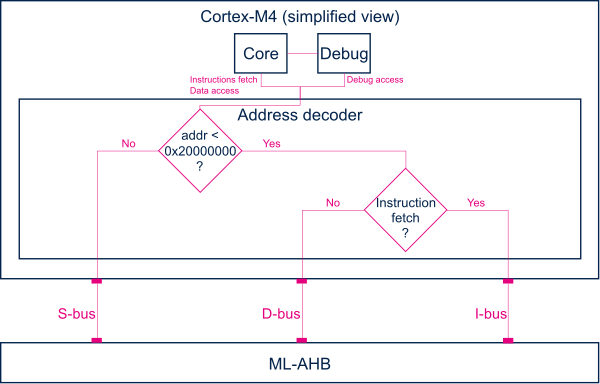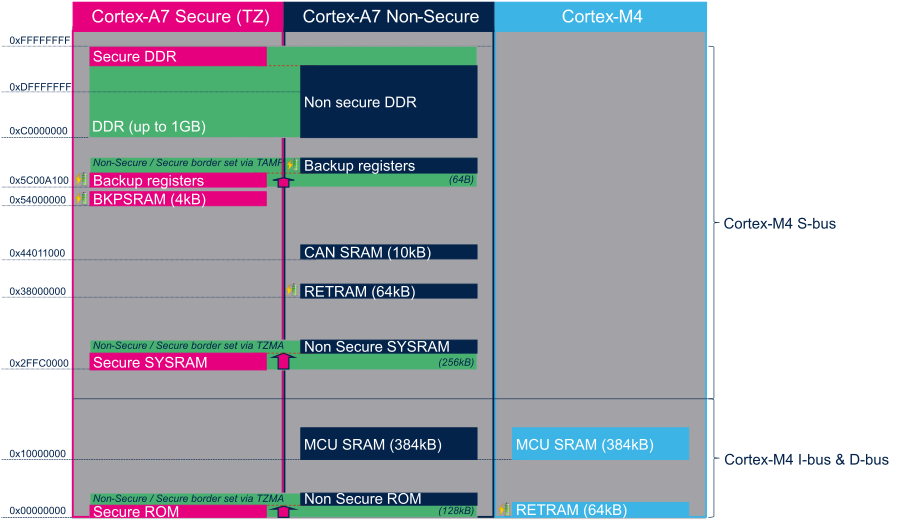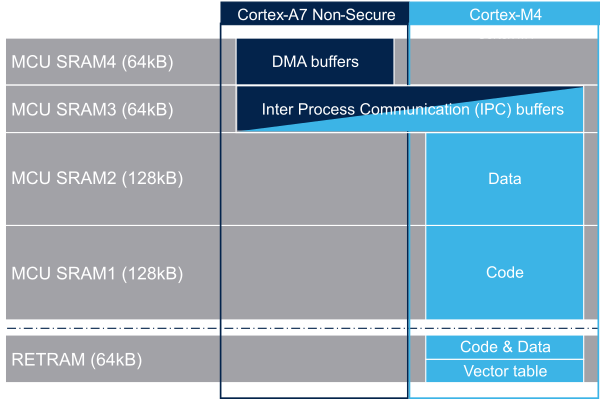1. Overview[edit source]
This article shows the default memory mapping defined by STMicroelectronics in STM32MPU Embedded Software. It uses a subset of all memory regions that are exposed at hardware level: customers may use other memory regions or aliases that are not shown here but are described in the STM32MP15 reference manuals.
2. Arm core characteristics[edit source]
Integration of Arm cores sets some constraints on the device memory mapping: the main ones are listed in this article.
2.1. Reset address[edit source]
Arm® Cortex® cores start running from address 0x00000000 on reset, which is why this address respectively points to:
- The ROM code on the Cortex-A7 side. This read-only memory embeds the boot code that is executed when the platform boots (and executes the boot chain) or wakes up from low power STANDBY mode.
- The Retention RAM on the Cortex-M4 side. This needs to be loaded by the Cortex-A7 before releasing the Cortex-M4 reset (in the RCC) and getting it running. This is done by Linux coprocessor management, by default.
Note: since the Cortex-A7 has its ROM code mapped at address 0x00000000, it uses a hardware alias to access the retention RAM at address 0x38000000
2.2. Cortex-M4 multiple ports[edit source]
The Cortex-M4 is connected to the interconnect (ML-AHB) via three ports, listed below and shown in the following figure:
- I-bus is used to fetch code instructions in the 0x00000000--0x1FFFFFFF address range
- D-bus is used to read/write data in the 0x00000000--0x1FFFFFFF address range
- S-bus is used for all accesses in the 0x20000000--0xFFFFFFFF address range; all STM32MP15 internal peripherals registers are mapped in this range.

Balancing the Cortex-M4 firmware accesses among those ports allows tuning of the system performance, which is why the MCU SRAM is defined in the first address range (from 0x10000000), but is also visible in the second range (from 0x30000000) in the STM32MP15 reference manuals.
Nevertheless, it is important to notice that the Cortex-M4 embedded in the STM32MP15 only allows hardware breakpoints to be set on the address range covered by the I-bus. Thus any code accessed via the S-bus has to be debugged through software breakpoints.
3. Memory mapping[edit source]
3.1. Overall memory mapping[edit source]
The memory mapping below is a subset of all regions that are exposed at hardware level: it shows the default configuration used in OpenSTLinux but the customer may choose a different mapping to take advantage of other address ranges defined in STM32MP15 reference manuals.

[edit source]
The figure below is a zoom of the RAM areas that are shared between the Cortex-A7 non-secure and the Cortex-M4. This mapping is STMicroelectronics' default implementation that can be freely adapted by customers to fit to other needs.

3.3. Possible customization of internal RAM[edit source]
As described in https://wiki.st.com/stm32mpu/wiki/MCU_SRAM_internal_memory, ST has defined a memory mapping to be able to enable all the possible use cases in parallel but this can be changed depending on customer use cases.
3.3.1. Overview[edit source]
- RETRAM is used for low power (code + data) and vector table. If not used for low power all this section can be used for any purpose (except the vector table).
- MCU SRAM1 (Code) and SRAM2 (Data) sizes can be tuned depending on user needs to better use physical area of 256KB.
- MCU SRAM3 (IPC Buffers) can be used for other purpose if IPC is not used
- MCU SRAM4 (dma) can be used for other purpose if dma1 and dma2 is not used in chained mode (only used in linux side)
3.3.2. How to do that in pratice[edit source]
3.3.2.1. RETRAM[edit source]
By default the RETRAM is reserved for the Cortex-M4 firmware. The base address is fixed, the size can be optimized to the size of the vector table section of the M4 firmware.
- Linux Device tree
retram: retram@0x38000000 {
compatible = "shared-dma-pool";
reg = <0x38000000 0x10000>;
no-map;
};
- No update needed for m4_proc node.
&m4_rproc {
memory-region = <&retram>, <&mcuram>, <&mcuram2>, <&vdev0vring0>,
<&vdev0vring1>, <&vdev0buffer>;
ranges = <0x00000000 0x38000000 0x10000>,
<0x30000000 0x30000000 0x60000>,
<0x10000000 0x10000000 0x60000>;
- Cortex-M4 STM32Cube firmware
- Must be aligned with STM32Cube linker script definition (.ld), keep vector table "m_interrupts":
MEMORY
{
m_interrupts (RX) : ORIGIN = 0x00000000, LENGTH = 0x00000298
}
3.3.2.2. MCU SRAM4[edit source]
By default the MCU SRAM4is reserved for DMA chaining for Linux features. It can be freed for some other purposes by removing following:
- Linux device tree
- Remove followings declarations:
sram: sram@10050000 {
compatible = "mmio-sram";
reg = <0x10050000 0x10000>;
#address-cells = <1>;
#size-cells = <1>;
ranges = <0 0x10050000 0x10000>;
dma_pool: dma_pool@0 {
reg = <0x0 0x10000>;
pool;
};
};
&dma1 {
sram = <&dma_pool>;
};
&dma2 {
sram = <&dma_pool>;
};
3.3.2.3. MCU SRAM3[edit source]
By default the MCU SRAM3 is reserved for the IPC. It can be freed for some other purposes by removing following:
- Linux device tree
- Remove followings memory declaration:
vdev0vring0: vdev0vring0@10040000 {
compatible = "shared-dma-pool";
reg = <0x10040000 0x2000>;
no-map;
};
vdev0vring1: vdev0vring1@10042000 {
compatible = "shared-dma-pool";
reg = <0x10042000 0x2000>;
no-map;
};
vdev0buffer: vdev0buffer@10044000 {
compatible = "shared-dma-pool";
reg = <0x10044000 0x4000>;
no-map;
};
- Remove associated reference in m4_rproc node:
&m4_rproc {
memory-region = <&retram>, <&mcuram>, <&mcuram2>,
<&vdev0vring0>, <&vdev0vring1>, <&vdev0buffer;
ranges = <0x00000000 0x38000000 0x10000>,
<0x30000000 0x30000000 0x60000>,
<0x10000000 0x10000000 0x60000>;
- Cortex-M4 STM32Cube firmware:
- Must be aligned with STM32Cube linker script definition (.ld), remove "m_ipc_shm":
MEMORY
{
m_ipc_shm (RW) : ORIGIN = 0x10040000, LENGTH = 0x00008000
}
3.3.2.4. MCU SRAM1 & SRAM2[edit source]
By default the MCU SRAM1 & SRAM2 are reserved for the STM32Cube firmware. it can be optimized depending on the Firmware needs.
- Linux device tree
- Only one section declared from STM32Cube firmware code and data in Linux device tree
- Notice that the MCURAm is aliased so accessible at addresses 0x10000000 or 0x30000000. In consequence mcuram2 and mcuram2 memory sections definitions have to be coherent.
mcuram: mcuram@ 0x30000000 { compatible = "shared-dma-pool"; reg = <0x10000000 0x40000>; /* define memory base and size for Cortex-M4 firmware*/ no-map; }; mcuram: mcuram@0x10000000 { compatible = "shared-dma-pool"; reg = <0x10000000 0x40000>; /* define memory base and size for Cortex-M4 firmware*/ no-map; };
- No update needed for m4_proc node.
&m4_rproc {
memory-region = <&retram>, <&mcuram>, <&mcuram2>, <&vdev0vring0>,
<&vdev0vring1>, <&vdev0buffer>;
ranges = <0x00000000 0x38000000 0x10000>,
<0x30000000 0x30000000 0x60000>,
<0x10000000 0x10000000 0x60000>;
- Cortex-M4 STM32Cube firmware
- Must be aligned with STM32Cube linker script definition (.ld):
MEMORY
{
m_text (RX) : ORIGIN = 0x10000000, LENGTH = 0x00020000
m_data (RW) : ORIGIN = 0x10020000, LENGTH =0x00020000
}